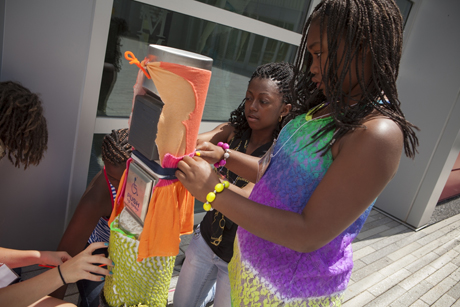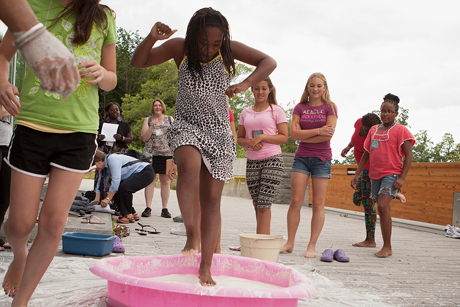Program teaches girls engineering via apparel design
By Ted Boscia


On a late July afternoon, 24 middle school girls took turns walking on water outside Cornell’s Human Ecology Building. The girls, from cities and small towns in upstate New York, pranced atop a goopy mixture of water and cornstarch, careful not to stop or it would grab them like quicksand. Their lesson was to learn about the properties of shear-thickening fluids – substances that morph between liquid and solid states and are used in some high-end body armors and protective gear.
The demonstration was one of dozens of lessons in science, technology, engineering and math (STEM) principles that the girls received as part of Smart Clothing, Smart Girls: Engineering via Apparel Design, a weeklong course designed and hosted by faculty, staff and students in Cornell’s Department of Fiber Science & Apparel Design (FSAD) with collaborators at the University of Minnesota. (Lucy Dunne ’02, M.A. ’04, associate professor of apparel design, led the Minnesota team.) Funded by the National Science Foundation, the program is intended to attract young girls to STEM careers, which continue to be filled predominantly by men.
Apparel design may be an unconventional way to learn about science, but program leader Susan Ashdown, M.A. ’89, the Helen G. Canoyer Professor in the FSAD Department, said that lots of scientific savvy goes into creating your favorite T-shirt.
“They have to understand physics, chemistry, biology, engineering, design and mathematics – and how to put all those elements together into a piece of clothing that looks and feels great,” Ashdown said.
Cornell researchers led the girls, from 4-H programs in Livingston, Ontario and Wyoming counties and the Syracuse chapter of Girls Inc., through four modules: advanced materials, wearable electronics, design technology and the engineering design process. The girls participated in hands-on laboratory and design activities, such as fiber burn tests, sewing and draping, and working with circuits and switches. They also observed such state-of-the-art equipment as a laser cutter, thermal manikin and 3-D body scanner – and worked alongside Cornell and industry experts, mostly women, (including a teleconference with a spacesuit designer at NASA).
By the end of the week, these young engineers were making out-of-this-world clothing. They teamed up to create spacesuits for an imaginary planet, where the atmospheric conditions demanded clothing that was protective, lightweight, durable, equipped for external communication – and fashionable. They unveiled their creations at a runway show at the end of the program.
“I’ve never been big into science in school, always wondering when I would actually use it in real life,” said Katie Terry, a ninth-grader from Wyoming County. “Seeing how it goes into fashion has made science a lot more relatable and fun for me.”
Said Roxanne Dueppengiesser ’88, 4-H extension educator in Wyoming County: “Our kids are sewers in our county, and they were really in awe of the technology here. It gives them lots of inspirations for future careers.”
Danielle Maddox, a teacher at Syracuse Girls Inc. who brought 11 girls to the program, noted, “They’ve had this college experience and can bring that back to inspire their entire community.”
Smart Clothing, Smart Girls leaders plan to expand the next year, and by the year after develop a curriculum and demonstration videos for youth programs around the country to teach STEM principles through apparel design.
The Cornell project was also led by Charlotte Coffman, FSAD senior extension associate; Fran Kozen ’72, M.S. ’77, FSAD lecturer; and Kristen Morris, a doctoral student in the field of apparel design.
Ted Boscia is assistant director of communications for the College of Human Ecology.
Media Contact
Get Cornell news delivered right to your inbox.
Subscribe